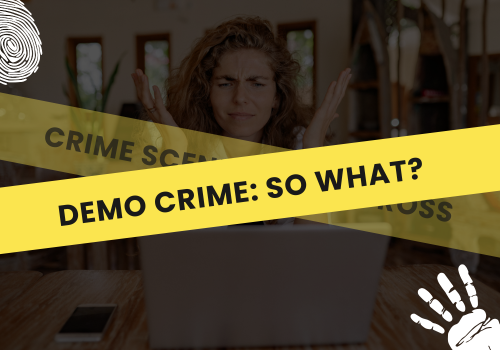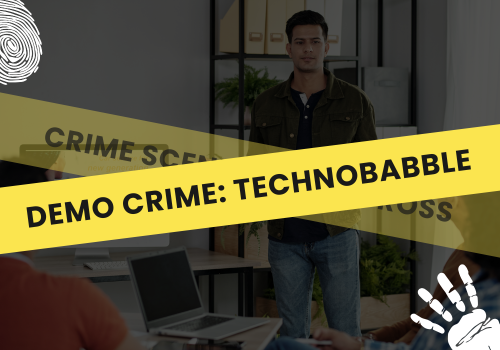Demo Crime: Technobabble
Demo Crimes for Modern Times: 2Win Demo Detectives Uncover Fresh Insights on Old Crimes

In a sales and presales function, certain demo crimes are considered especially heinous. At 2Win! Global, the dedicated demo detectives who investigate presentation crimes are an elite squad of facilitators, executives, and presales leaders.
These are their stories.
One of our most famous demo crimes occurs when a presenter showcases a product feature without connecting to why the audience should care. Without a bridge to the value it provides, your audience will not care or share in your excitement, and it will be more challenging to regain attention. They will effectively lose interest in the presentation.
This is more than just a slip, it’s a missed opportunity to make your software matter. When a buyer hears a capability without context or benefit, they’re left asking, “So what?” And once that question is in their mind, you’ve lost your moment to move them closer to value.
Humans are driven by a hierarchy of needs, with physiological and safety needs taking precedence over higher-level needs like belonging and self-actualization. This is the basis of Maslow's Hierarchy of Needs, a theory developed by psychologist Abraham Maslow that proposes that humans have a hierarchy of needs, starting with basic physiological needs and progressing to safety, love, and belonging, esteem, and finally, self-actualization. Where does this fit into selling? We lose audience attention when we lose sight of a need or fail to prove value as it applies to an individual.
Hence, so what?
This crime consistently appears across SaaS sales organizations across all industries, from Fintech to healthcare, because enthusiasm for features outweighs the discipline of tying features to outcomes, or tying to a need.
Let’s call it what it is: demoing without direction. The allure of teaching the tech is real, especially for those who know the software inside and out. But when you slip into teaching mode, you leave behind the very thing your prospect came for: the benefit. Every feature must be connected to a purpose. Without that, your audience is just watching clicks on a screen, not a solution to their problem.
Buyers are coming to sellers with more information on solutions. Often they try to take control or a demo, asking specific questions and a solutions engineer gets dragged all over the place, losing adequate structure, and without being able to tie context or benefits. Additionally, Solutions Engineers and presales professionals are trained so deeply in software capabilities that they get caught up in the excitement of their product’s bells and whistles, assuming that the audience will, too.
An SE showcases an analytics dashboard to a prospective client in the healthcare sector. They show metrics, charts, and widget capabilities, without tying the capability back to client needs, which were identified as enhancing operational efficiency or reducing administrative overhead. The audience nods politely and silently nods off on the rest of the presentation.
“So what?” echoes quietly in the room. And once that question enters the buyer’s mind, everything that follows is noise.
The core issue here is that more is not better for your audience. But often presales professionals wrongly assume that if you show more features, an audience will be more impressed and more likely to buy.
Spoiler alert: that’s almost never the case.
Each feature must pass the “So What?” test before it ever leaves your mouth. If a feature has no direct benefit to this specific audience, skip it. You’re not just showing software—you’re building a case for value.
The value must be evident in the first sentence, think spotlight and megaphone, and resist the urge to dive deep into other functions.
Commit the crime, serve the time! The correction for the “So What” crime is simple but requires patience and practice.
Build a habit: every time you present a capability, immediately connect it to what it helps your prospect achieve. Don’t say, “This view shows server traffic.” Say, “This view helps you proactively spot server slowdowns, so you can respond before users even notice.”
Do not deviate from your structure. If you are not prepared to show a specific feature, take more time to deliver it. Buyers are more comfortable receiving asynchronous information, so you can provide it via video or email. Also, even if you are very excited about a new feature, always remember that you are in sales and must explicitly tie the feature to a benefit that matters to your audience.
If you find yourself excited to show a new capability, pause and ask: why should they care? Train yourself to ask “So what?” in your head before you say anything out loud. If there’s no answer, don’t say it. You’ll deliver a leaner, tighter, more impactful demo.
Note the Difference in saying, “Our platform provides real-time analytics,” and “Our platform provides real-time analytics, allowing you to reduce administrative costs.”
Bonus Tip: Flip the focus back to them: “How do you see this feature fitting into your workflow?”
That’s how you create a conversation, not a monologue.
“So What” is just as easily prevented as it is committed. Answer the unspoken question in your audience’s mind and tie all features to benefits.
If the buyer starts taking over the demo, it’s your job to anchor the conversation back to the value story. That’s why structure matters.
Our Demo2Win training teaches techniques that divert these crimes by creating flows of features that consistently add value and engage audiences. These are proven and have yielded decades of success in presales and solutions organizations.
So don’t get caught committing this crime. Train with Demo2Win and never again leave your audience wondering, “So what?”

Demo Crimes for Modern Times: 2Win Demo Detectives Uncover Fresh Insights on Old Crimes

Ideally, we should know what our client wants to see before the meeting starts. But it doesn't always work out that way. More demos are becoming...